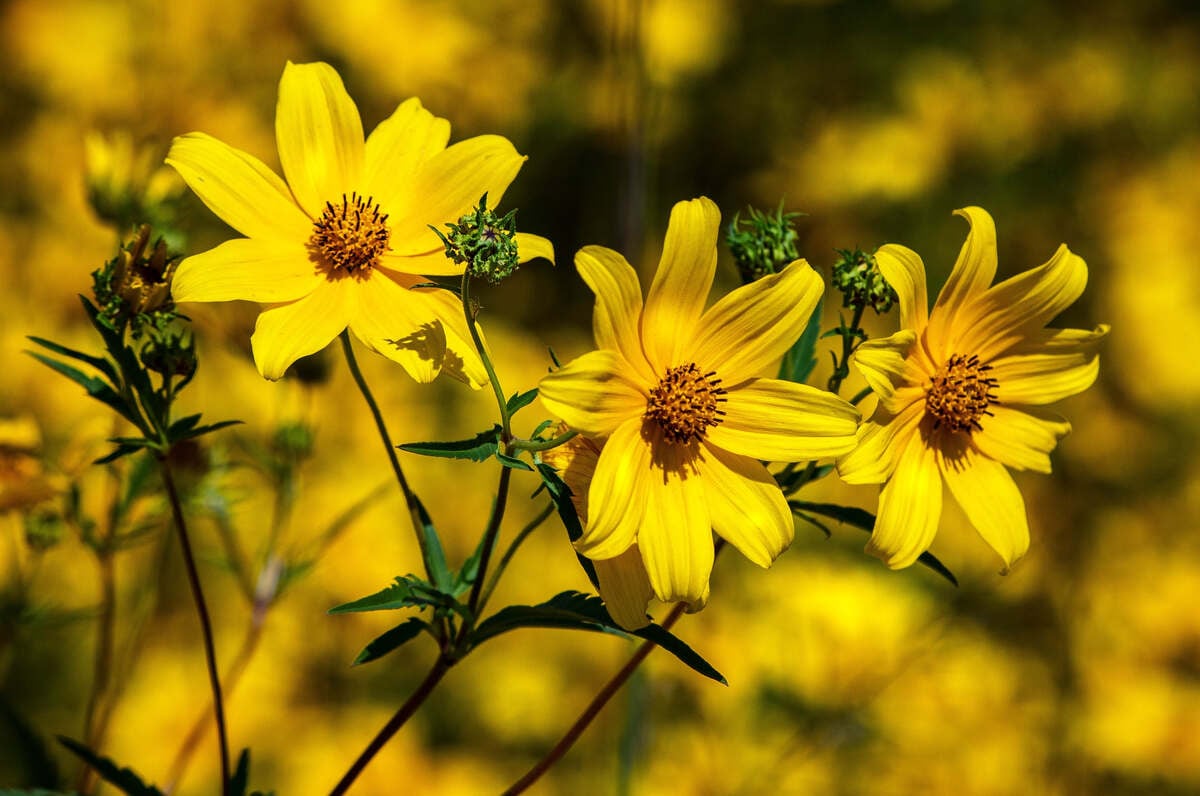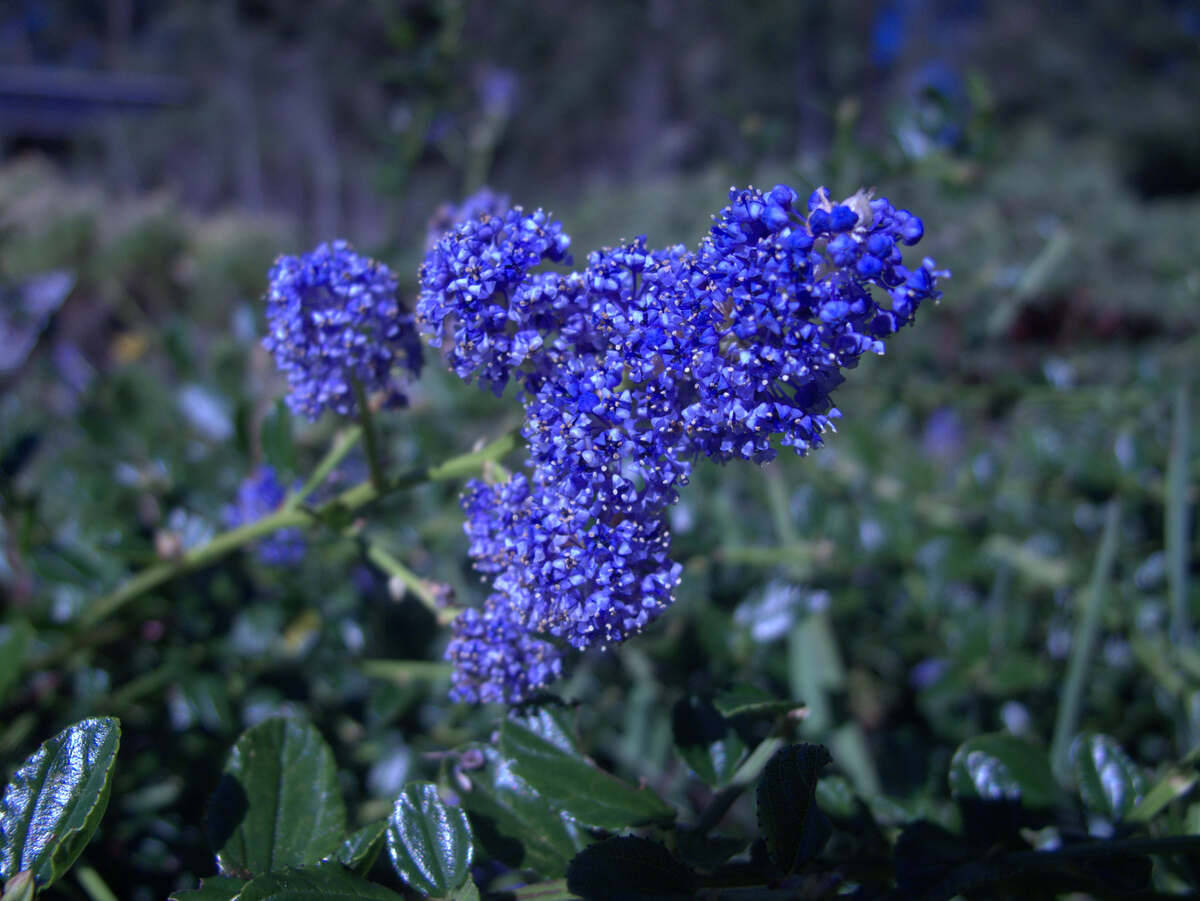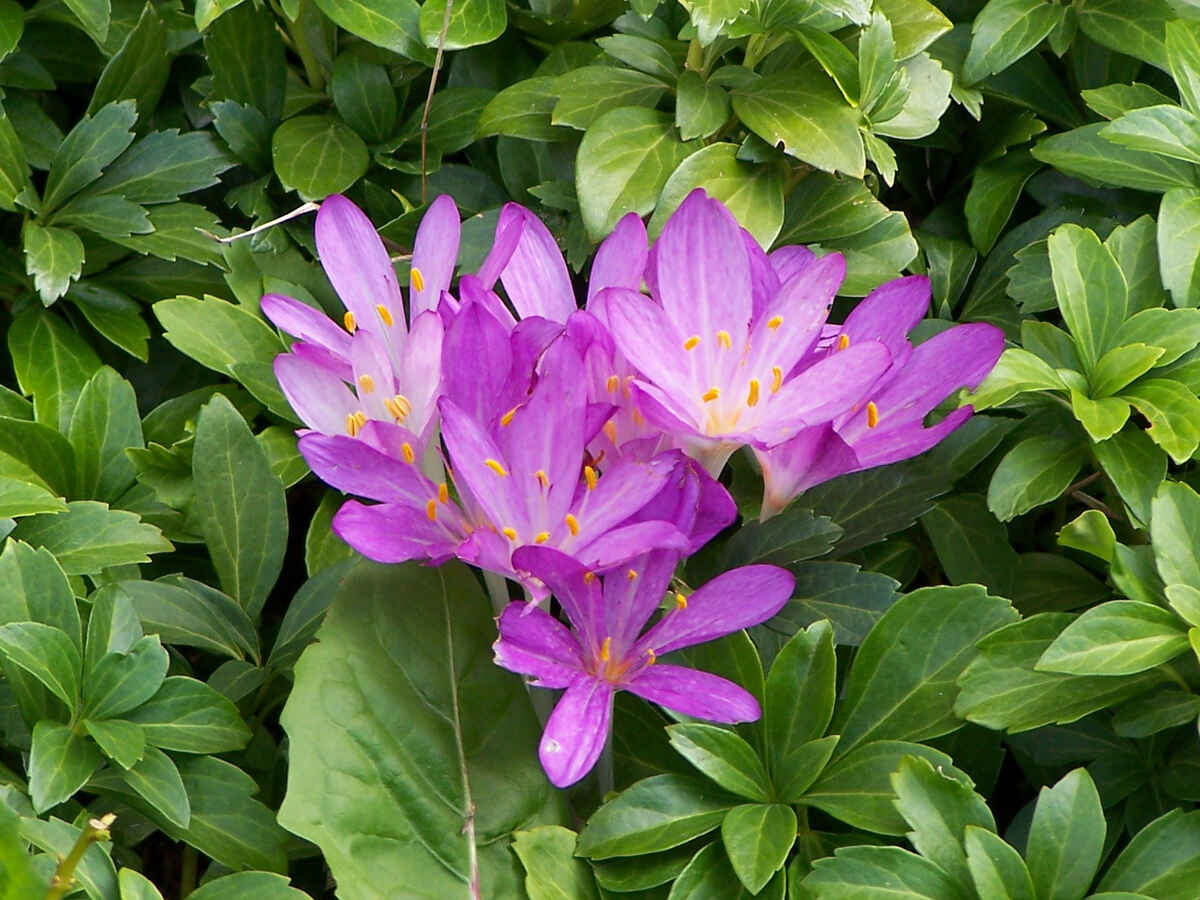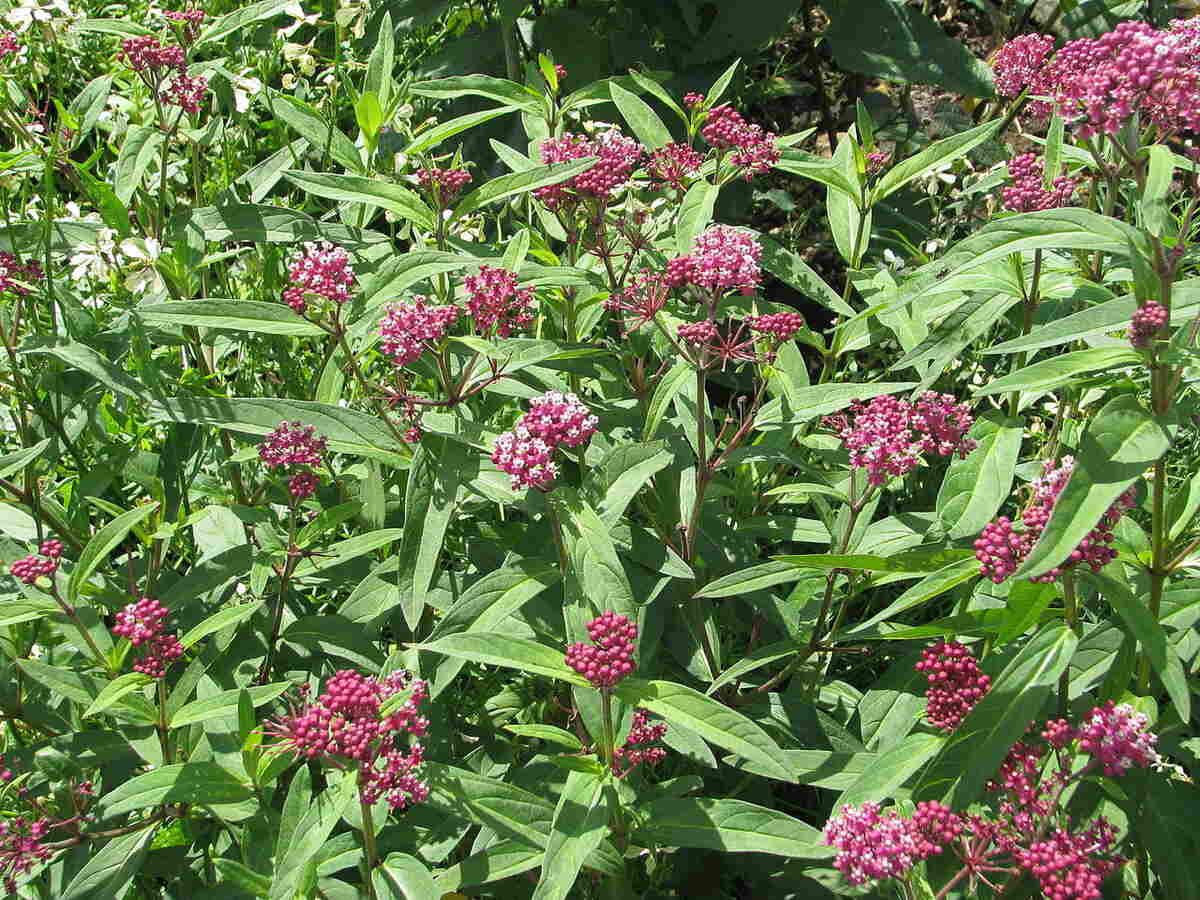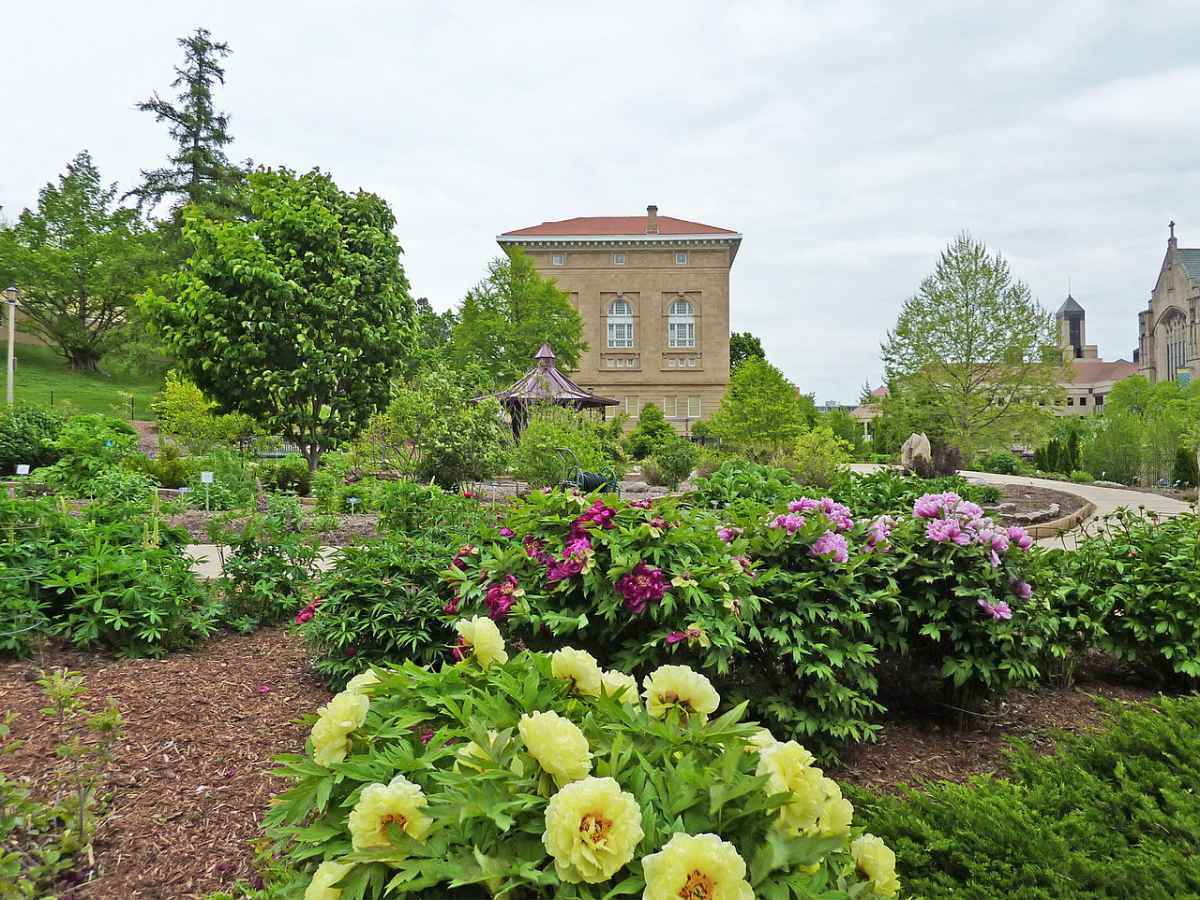
If you want to elevate the beauty of your Wisconsin garden and landscape, you must incorporate native plants! Not only do they add a lovely touch to your outdoor space, but they also play an essential role in supporting the local ecosystem and are easier to maintain than non-natives.
So let’s love our Wisconsin native plants and watch our gardens thrive! Check out this list of unique plants native to different regions of Wisconsin that are sure to make your garden pop.
- 1. White Baneberry (Actaea pachypoda)
- 2. Downy Serviceberry (Amelanchier arborea)
- 3. Canadian Anemone (Anemone canadensis)
- 4. Eastern Red Columbine (Aquilegia canadensis)
- 5. Wild Bergamot (Monarda fistulosa)
- 6. Black-eyed Susan (Rudbeckia hirta)
- 7. Wild Cranesbill (Geranium maculatum)
- 8. American Elderberry (Sambucus canadensis)
- 9. Culver’s Root (Veronicastrum virginicum)
- 10. Stiff Goldenrod (Oligoneuron rigidum)
- 11. Maidenhair Fern (Adiantum pedatum)
- 12. Nannyberry (Viburnum lentago)
- 13. Downy Phlox (Phlox pilosa)
- 14. Swamp Milkweed (Asclepias incarnata)
- 15. Butterfly Weed (Asclepias tuberosa)
- 16. Sand Coreopsis (Coreopsis lanceolata)
- 17. Showy Tick Trefoil (Desmodium canadense)
- 18. Purple Coneflower (Echinacea purpurea)
- 19. Gray Dogwood (Cornus racemosa)
- 20. New England Aster (Aster novae-angliae)
- 21. Lady’s Leek (Allium cernuum)
- FAQ
1. White Baneberry (Actaea pachypoda)
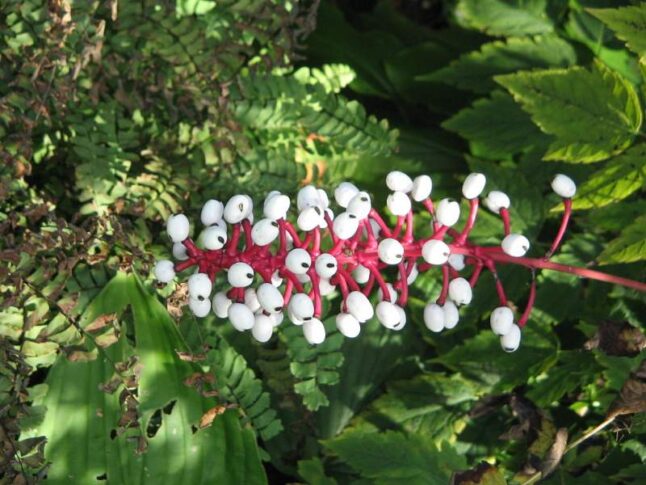
White baneberry (scientific name Actaea pachypoda), often known as doll’s eyes, is a natural wildflower that will make your Wisconsin native garden stand out. The flower stems are hairless and green, with a stunning purplish tint at the node. In late summer, they grow the most beautiful white berries, which, though lovely to look at, can be toxic to humans.
- Hardiness Zones: 3-9
- Plant Type: Perennial
- Sun: Partial Sun, Shade
- Blooming Season: Late Spring, Summer, Fall
- Height: 1-3 ft
- Water Needs: Average
- Maintenance: Low
- Soil Type: Clay, Loam
- Soil pH: Acid, Alkaline, Neutral
- Characteristics: Fragrant, Showy
2. Downy Serviceberry (Amelanchier arborea)
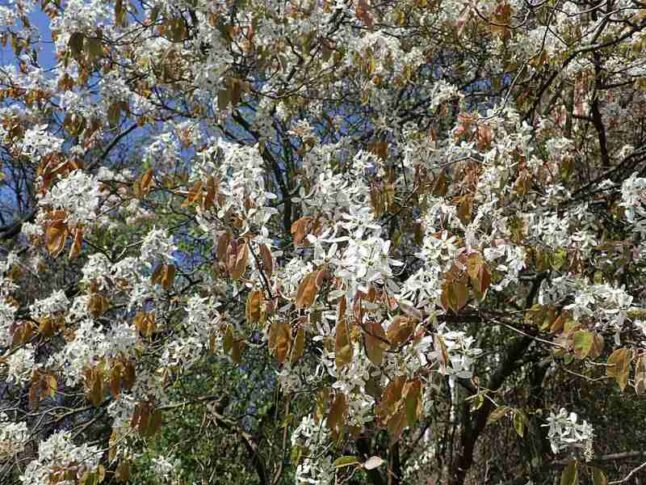
Downy serviceberry, also known as smooth shadbush and common serviceberry, is a big deciduous shrub with an early flowering season. Pollinators are attracted to its flowers, and by early summer, they produce small, delicious, purplish-black berries. Downy serviceberry offers year-round visual interest and thrives particularly well in natural environments.
- Hardiness Zones: 4-9
- Plant Type: Shrub
- Sun: Full sun, Partial sun
- Blooming Season: Spring
- Height: 15-25 ft
- Water Needs: Low to Average
- Maintenance: Low
- Soil Type: Clay, Loam, Sand
- Soil pH: Acid, Neutral
- Characteristics: Fragrant, Showy, Edible Berries
3. Canadian Anemone (Anemone canadensis)
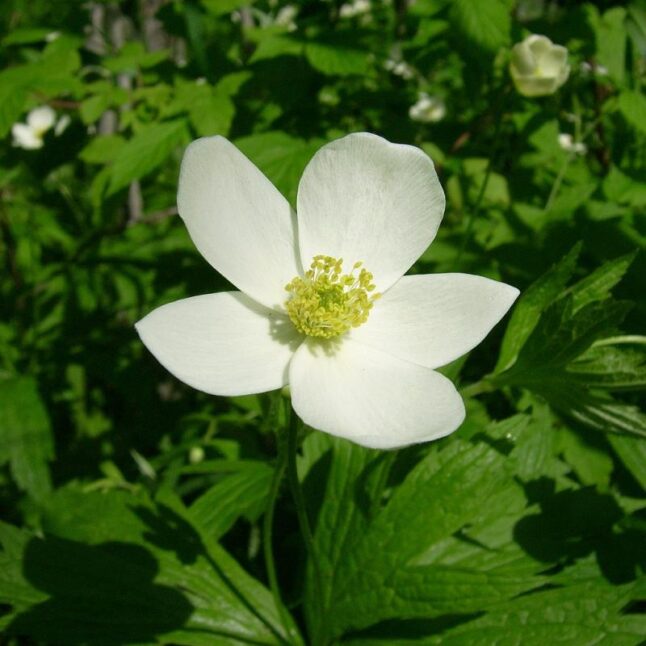
Canadian anemone has several common names, such as meadow anemone, round-leaf anemone, and windflower. This flower is a member of the Buttercup family and features a stunning golden core in the center. This plant has great potential to thrive in gardens, and with proper management, it can be an excellent addition to your landscape.
- Hardiness Zones: 3-8
- Plant Type: Perennial
- Sun: Partial sun, Shade
- Blooming Season: Spring (Mid, Late), Early Summer
- Height: 1-2 ft
- Water Needs: Average to High
- Maintenance: Low
- Soil Type: Chalk, Clay, Loam, Sand
- Soil pH: Acid, Alkaline, Neutral
- Characteristics: Showy
4. Eastern Red Columbine (Aquilegia canadensis)
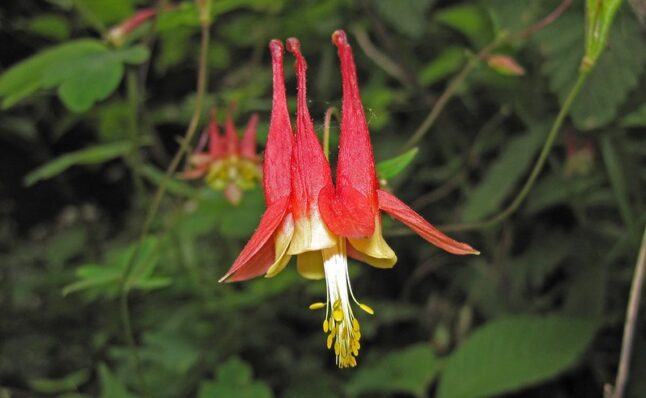
Native to Wisconsin, the eastern red Columbine is a brilliant and flamboyant choice for your yard. Canadian columbine or wild Columbine are other common names for this flower.
Gorgeous red and yellow blooms dangle from the 2-foot-tall branches of this shrub in May and June. These are not only aesthetically pleasing but will also bring pollinators like bees and hummingbirds to your garden.
- Hardiness Zones: 3-8
- Plant Type: Perennial
- Sun: Full sun, Partial sun
- Blooming Season: Spring, Summer
- Height: 2-3 ft
- Water Needs: Low to Average
- Maintenance: Low
- Soil Type: Chalk, Clay, Loam, Sand
- Soil pH: Acid, Alkaline, Neutral
- Characteristics: Cut flowers, Showy, Attracts Pollinators
5. Wild Bergamot (Monarda fistulosa)
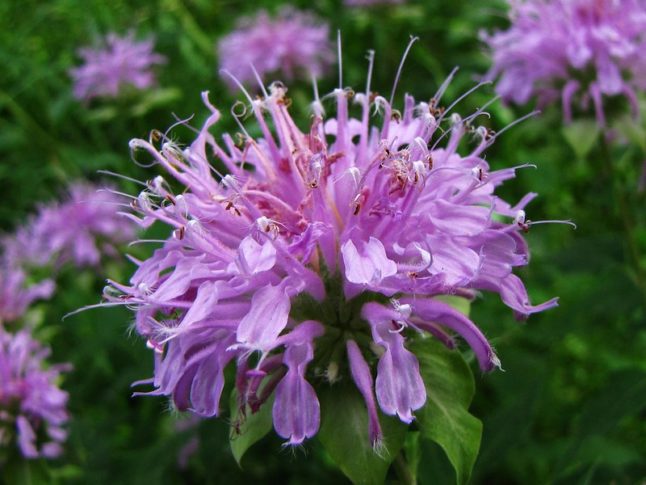
Wild bergamot, often known as bee balm, is a widely distributed native plant across Wisconsin. The plant produces antiseptic thymol that homeowners can use to treat sore throats and other cold symptoms. In its native range, many pollinators frequently visit bee balm, including hummingbirds and bees.
- Hardiness Zones: 3-9
- Plant Type: Perennial
- Sun: Full sun, Partial sun
- Blooming Season: Summer, Fall
- Height: 2-4 ft
- Water Needs: Low to Average
- Maintenance: Low
- Soil Type: Chalk, Clay, Loam, Sand
- Soil pH: Acid, Alkaline, Neutral
- Characteristics: Cut flowers, Fragrant, Showy, Medicinal use, Attracts pollinators
6. Black-eyed Susan (Rudbeckia hirta)

Black-eyed Susan, aka Rudbeckia hirta, is a native plant that grows either as a biennial or a short-lived perennial. Its distinctive yellow daisy-like flowers have a chocolate brown disk at their centers.
Pollinators, such as birds and butterflies, are attracted to these flowers. This native plant is capable of self-seeding and maintains steady reproduction in its natural habitat. Black-eyed Susans can handle high temperatures, drought, and a wide variety of soil types.
- Hardiness Zones: 3-10
- Plant Type: Perennial or biennial
- Sun: Full sun
- Blooming Season: Spring, Summer, Fall
- Height: 2-3 ft
- Water Needs: Low to Average
- Maintenance: Low
- Soil Type: Clay, Loam
- Soil pH: Acid, Alkaline, Neutral
- Characteristics: Cut flowers, Showy, Attracts pollinators
7. Wild Cranesbill (Geranium maculatum)
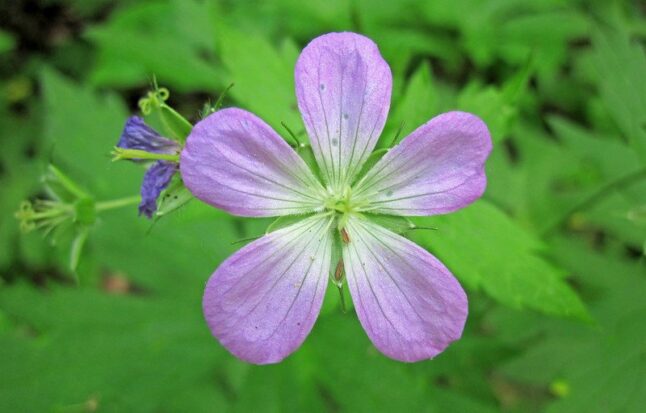
This plant is frequently found in forested areas of Wisconsin and can also be observed in prairie ecosystems and open woodland environments. The plant-bearing lavender-hued flowers exhibit adaptability to a wide range of soil types and light conditions but require regular irrigation when exposed to direct sunlight.
The plant provides natural resources for bees and serves as a habitat for various moth species. Add this plant to your rock garden or landscape border for an appropriate and ideal touch.
- Hardiness Zones: 3-8
- Plant Type: Perennial
- Sun: Full sun, Partial Sun
- Blooming Season: Late Spring, Early Summer
- Height: 1-2 ft
- Water Needs: Low to Average
- Maintenance: Low
- Soil Type: Chalk, Clay, Loam, Sand
- Soil pH: Acid, Alkaline, Neutral
- Characteristics: Showy, Attracts pollinators
8. American Elderberry (Sambucus canadensis)
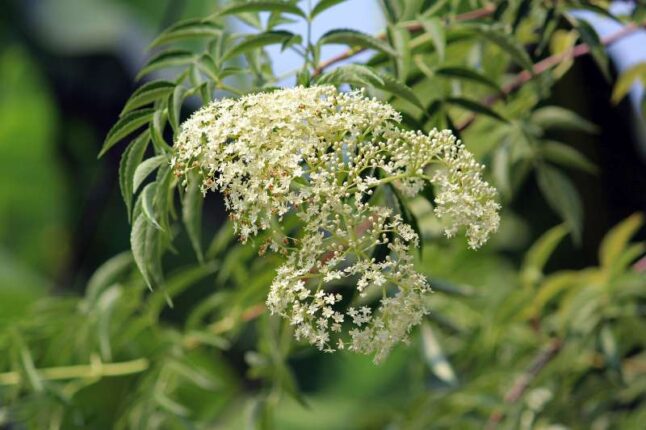
The American elderberry is a shrub with many stems and deciduous leaves. Its voluminous foliage comprises seven leaflets, bright green and deeply serrated—this plant blooms in the spring and summer with flat bunches of white flowers with a citrus aroma. The American elderberry’s fruit can be used for making natural jams, jellies, and wine, and it attracts birds.
- Hardiness Zones: 3-9
- Plant Type: Shrub
- Sun: Full sun, partial sun
- Blooming Season: Summer (Early, Mid)
- Height: 5-12 ft
- Water Needs: Low to Average
- Maintenance: Average
- Soil Type: Chalk, Clay, Loam, Sand
- Soil pH: Acid, Alkaline, Neutral
- Characteristics: Fragrant, Showy, Edible berries, Attracts birds
9. Culver’s Root (Veronicastrum virginicum)
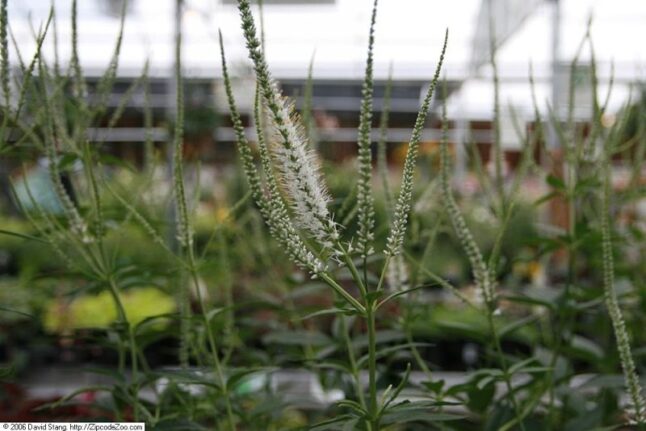
Culver’s root is a popular Wisconsin native plant among homeowners due to its ornamental leaves and blossoms. During the summer, Culver’s root exhibits spear-shaped white flowers. It prefers soils with good drainage and moisture.
The flowers may exhibit an aesthetically pleasing hue of pink or purple during the fall. The vertical arrangement of flowers on the stem of this plant consists of elongated and narrow clusters that look like spikes.
- Hardiness Zones: 3-8
- Plant Type: Perennial
- Sun: Full sun
- Blooming Season: Summer (Mid, Late), Early Fall
- Height: 4-7 ft
- Water Needs: Average to High
- Maintenance: Low
- Soil Type: Clay, Loam, Sand
- Soil pH: Acid, Alkaline, Neutral
- Characteristics: Cut flowers, Showy
10. Stiff Goldenrod (Oligoneuron rigidum)
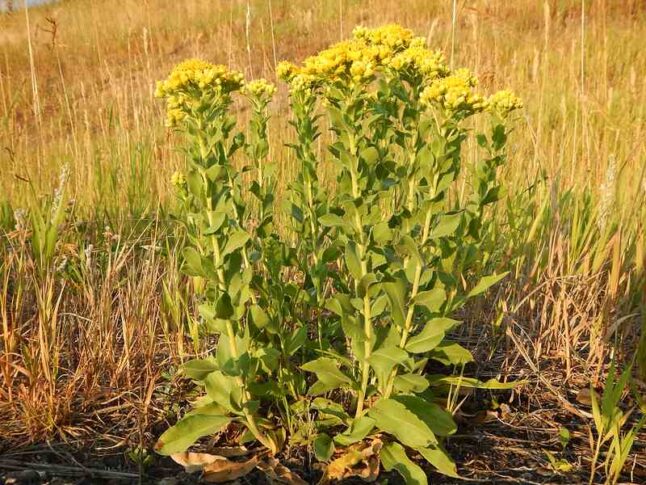
The stiff goldenrod, also known as Solidago rigida, thrives in arid outdoor regions with hard or sandy surfaces. During the later months of summer and early fall, the solidly structured Solidago rigida plant species produces its visually appealing yellow-hued flowers that are attractive to bees, butterflies, and flies.
- Hardiness Zones: 3-9
- Plant Type: Perennial
- Sun: Full sun
- Blooming Season: Late summer, Fall
- Height: 3-5 ft
- Water Needs: Low to Average
- Maintenance: Average
- Soil Type: Clay, Loam, Sand
- Soil pH: Acid, Alkaline, Neutral
- Characteristics: Showy, Attracts pollinators
11. Maidenhair Fern (Adiantum pedatum)
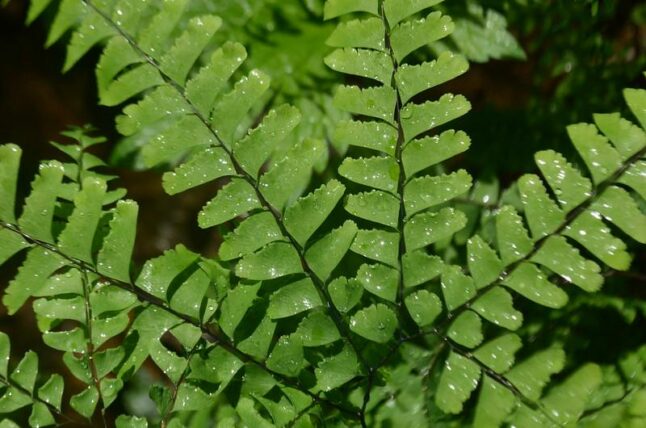
The maidenhair fern is a perennial fern that sheds its leaves annually. It is characterized by its attractive, shiny black stems and elegant, horizontally spreading bright green leaves that form a circular arrangement.
Maidenhair ferns can propagate gradually by extending creeping root systems, ultimately creating expansive plant communities. If your garden has partial shade and your soil is rich in nutrients and drains well, this plant is worth adding to fill space.
- Hardiness Zones: 3-8
- Plant Type: Fern
- Sun: Partial Sun, Shade
- Blooming Season: Summer, Fall
- Height: 1-3 ft
- Water Needs: Average
- Maintenance: Low
- Soil Type: Chalk, Clay, Loam, Sand
- Soil pH: Acid, Alkaline, Neutral
- Characteristics: Showy, Self-propagates
12. Nannyberry (Viburnum lentago)
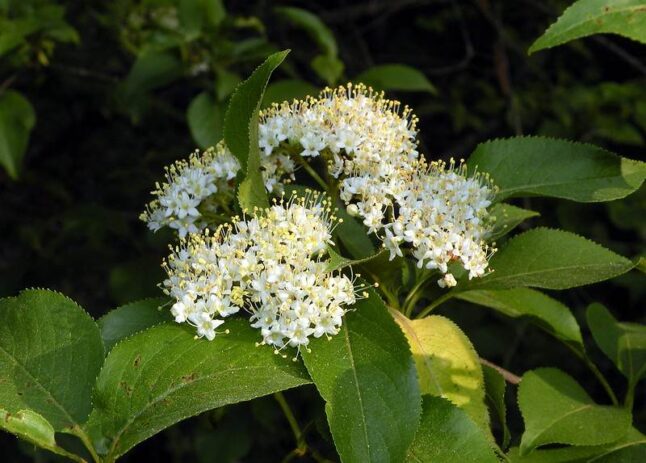
Nannyberry is a member of the Viburnum family and a pest-free native shrub that thrives in wet environments but can also flourish in dry climates. It has the potential to be a small tree or shrub and can survive in partial shade, but it grows more rapidly when exposed to full sun.
In spring, the plant produces fruits and creamy white blossoms that give your garden a stunning appearance. Since it thrives in wet soil, nannyberry is a good choice for a rain garden. The non-fragrant flowers of nannyberry attract butterflies, bees, and other pollinators.
- Hardiness Zones: 2-8
- Plant Type: Shrub, Small Tree
- Sun: Full sun, Partial sun
- Blooming Season: Late Spring, Early Summer
- Height: 10-20 ft
- Water Needs: Average
- Maintenance: Low
- Soil Type: Clay, Loam, Sand
- Soil pH: Acid, Alkaline, Neutral
- Characteristics: Showy, Attracts pollinators, Tolerates wet soil
13. Downy Phlox (Phlox pilosa)
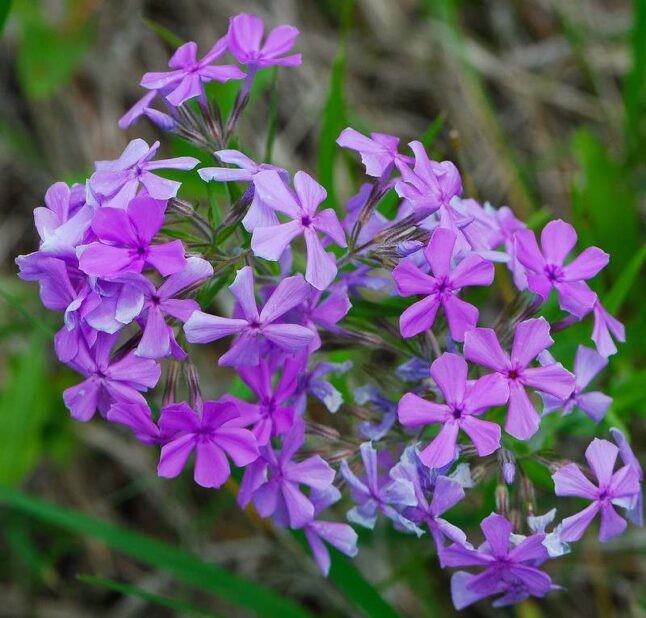
Prairie phlox, or downy phlox, is a perennial with erect stems that grow in bunches. It works wonderfully in various landscapes, including native plant gardens, meadows, and wild and cottage gardens. The flowers’ nectar is a feast for pollinators, so you’ll see lots of bees, butterflies, and hummingbirds visiting your garden.
- Hardiness Zones: 4-9
- Plant Type: Perennial
- Sun: Full sun
- Blooming Season: Late Spring, Summer
- Height: 1-2 ft
- Water Needs: Average to High
- Maintenance: Average
- Soil Type: Clay, Loam, Sand
- Soil pH: Acid, Neutral
- Characteristics: Fragrant, Showy, Attracts pollinators
14. Swamp Milkweed (Asclepias incarnata)
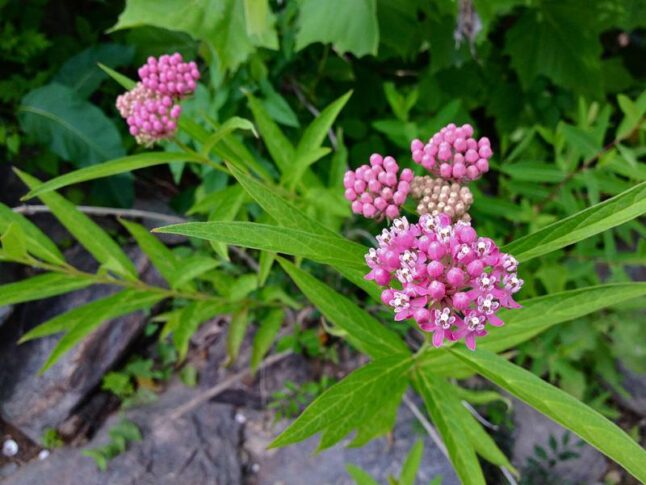
Swamp milkweed will thrive the best when you plant it in moist, marshy, or wet environments. Because of its lovely pink blossoms, this plant is also called “pink milkweed” and is excellent for attracting native bees and butterflies to your gardens.
- Hardiness Zones: 3-11
- Plant Type: Perennials
- Sun: Full sun
- Blooming Season: Summer, Early Fall
- Height: 4-5 ft
- Water Needs: Average to High
- Maintenance: Low
- Soil Type: Clay, Loam
- Soil pH: Acid, Alkaline, Neutral
- Characteristics: Fragrant, Showy, Attracts pollinators
15. Butterfly Weed (Asclepias tuberosa)
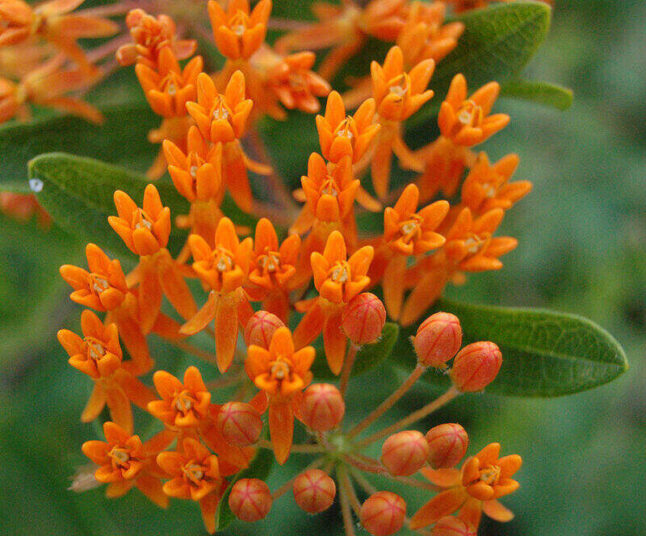
Another milkweed type that will bring a variety of winged visitors to your garden is the butterfly weed. This shrubby perennial prefers dry to damp soil with good drainage and bears big clusters of orange flowers with flat crowns at the ends of their branches. It is also known by its common names chigger flower, orange milkweed, and pleurisy root.
- Hardiness Zones: 3-9
- Plant Type: Perennial
- Sun: Full sun
- Blooming Season: Late Spring, Summer, Early Fall
- Height: 1-2 ft
- Water Needs: Low
- Maintenance: Low
- Soil Type: Clay, Loam, Sand
- Soil pH: Acid, Alkaline, Neutral
- Characteristics: Dried arrangements, Cut flowers, Showy, Attracts pollinators
16. Sand Coreopsis (Coreopsis lanceolata)
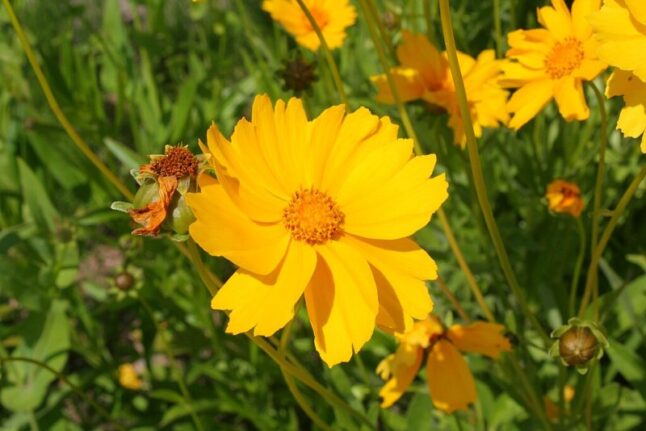
Sand coreopsis, or lanceleaf coreopsis, is a member of the aster family and a native of most of North America. The center of the flowers is disc-shaped and yellow. This plant thrives in rocky, arid conditions. The bright golden flowers look great in gardens and are great for bringing in pollinators such as butterflies, skippers, moths, bees, wasps, and beetles.
- Hardiness Zones: 4-9
- Plant Type: Perennial
- Sun: Full sun
- Blooming Season: Spring, Summer
- Height: 1-2 ft
- Water Needs: Low
- Maintenance: Low
- Soil Type: Chalk, Loam, Sand
- Soil pH: Acid, Alkaline, Neutral
- Characteristics: Cut flowers, Showy, Attracts pollinators
17. Showy Tick Trefoil (Desmodium canadense)
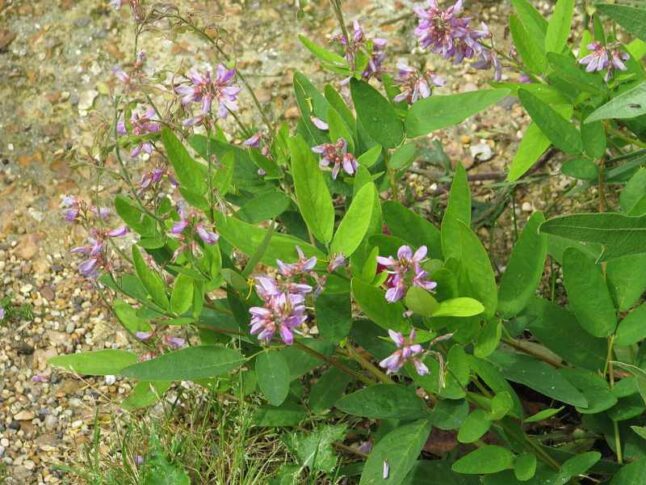
The showy tick trefoil, a pea family member, is an unusual flowering perennial. It bears hundreds of pea-shaped, rose-colored blooms at the tips of its stalks, giving it a bushy appearance. It thrives in various environments and may quickly take over a garden in the right conditions. It will serve as a magnet for pollinators like bees and hummingbirds.
- Hardiness Zones: 3-7
- Plant Type: Perennial
- Sun: Full sun, Partial sun
- Blooming Season: Summer, Early Fall
- Height: 3-5 ft
- Water Needs: Low to Average
- Maintenance: Low
- Soil Type: Clay, Loam, Sand
- Soil pH: Acid, Alkaline, Sand
- Characteristics: Cut flowers, Showy, Attracts pollinators
18. Purple Coneflower (Echinacea purpurea)
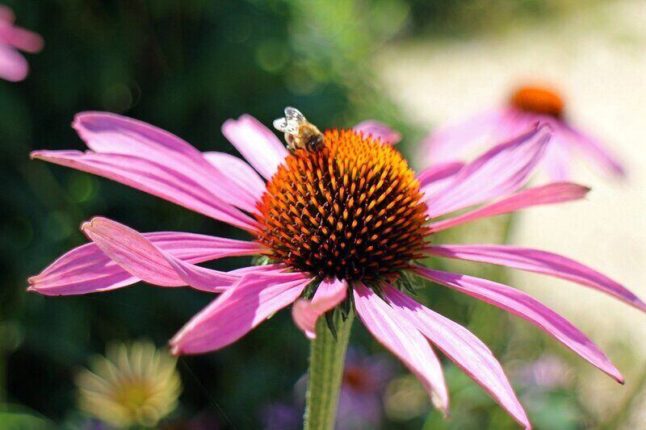
The purple coneflower is an eye-catching perennial that will thrive in your natural garden. The flowers of this plant species resemble miniature purple sunflowers. The purple coneflower is distinguished by its pink or purple flowers with a central orange or brown disc. Coneflowers attract butterflies and hummingbirds because of their pollen.
- Hardiness Zones: 3-8
- Plant Type: Perennial
- Sun: Full sun
- Blooming Season: Spring (mid, late), Summer, Early Fall
- Height: 2-5 ft
- Water Needs: Low to Average
- Maintenance: Low
- Soil Type: Clay, Loam, Sand
- Soil pH: Acid, Alkaline, Neutral
- Characteristics: Cut flowers, Showy, Attracts butterflies and hummingbirds
19. Gray Dogwood (Cornus racemosa)
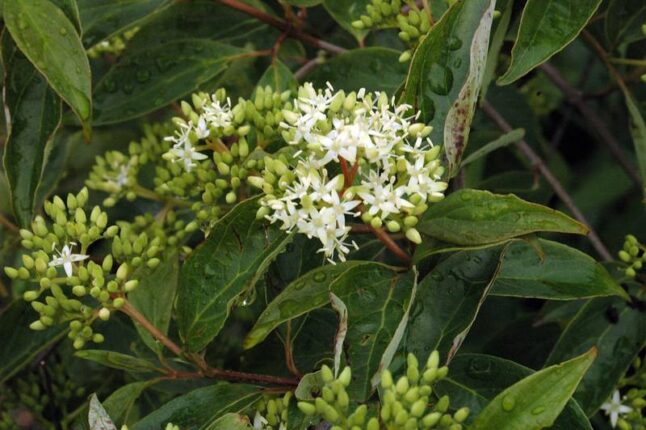
Gray dogwood, or Cornus racemosa, is a hardy deciduous shrub with blue-green leaves native to and widely distributed over Eastern North America. In late spring, linear clusters bear stunning white blooms that mature into white berries in the fall.
The shrub’s 2-4 inch long lance-shaped green leaves turn dark purplish red in the fall. Butterflies, birds, and bees are particularly attracted to this plant.
- Hardiness Zones: 4-8
- Plant Type: Shrub
- Sun: Full sun, Partial sun, Shade
- Blooming Season: Late spring, Summer
- Height: 3-6 ft
- Water Needs: Average
- Maintenance: Average
- Soil Type: Chalk, Clay, Loam, Sand
- Soil pH: Acid, Alkaline, Neutral
- Characteristics: Cut flowers, Showy, Attracts pollinators
20. New England Aster (Aster novae-angliae)
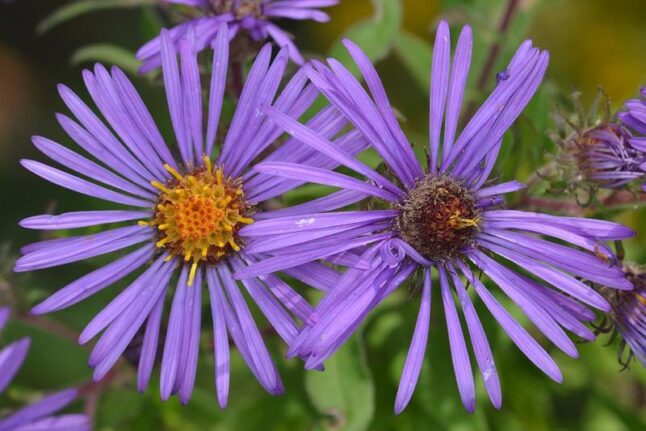
New England aster, a tall, erect perennial with daisy-like flowers, is one of the most stunning asters. This beautiful plant thrives in various soil conditions and has an orange center with bright purple petals.
This Wisconsin native flower is a show-stopper in the garden at the end of summer. It is low maintenance, long-lived, and beautiful in the autumn. Bumblebees, leafcutter bees, bee flies, and miner bees pollinate the flowers.
- Hardiness Zones: 4-8
- Plant Type: Perennial
- Sun: Full sun
- Blooming Season: Late Summer, Fall
- Height: 3-6 ft
- Water Needs: Average
- Maintenance: Average
- Soil Type: Chalk, Clay, Loam, Sand
- Soil pH: Acid, Alkaline, Neutral
- Characteristics: Cut flowers, Showy, Attracts pollinators
21. Lady’s Leek (Allium cernuum)
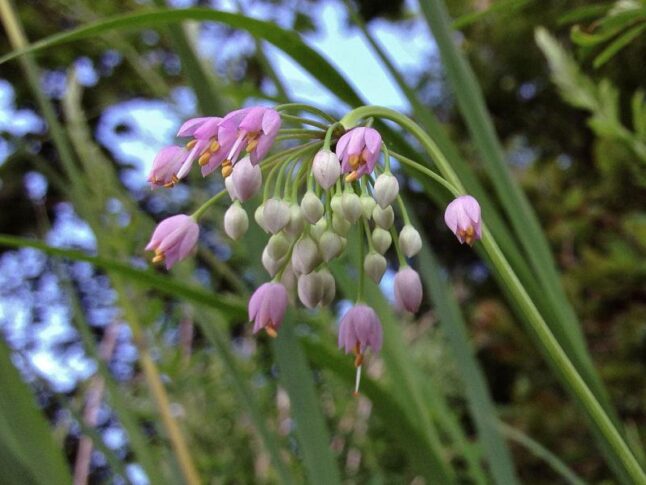
The lady’s leek, also known as nodding wild onion, has thin and long foliage with a gray-green color. The stem tips are covered in snake-like nodding buds that eventually open into spherical clusters of light lavender-purple flowers of 3 to 5 inches in diameter. This plant mainly attracts bees and butterflies. Allium cernuum will be an excellent addition to your rock or herb garden.
- Hardiness Zones: 3-9
- Plant Type: Bulbs
- Sun: Full sun, Partial Sun
- Blooming Season: Summer (Early, Mid)
- Height: 1-2 ft
- Water Needs: Average
- Maintenance: Low
- Soil Type: Chalk, Clay, Loam, Sand
- Soil pH: Acid, Alkaline, Neutral
- Characteristics: Cut flowers, Fragrant, Attracts pollinators
FAQ
Ornamental grasses such as little bluestem, switchgrass, Panicum virgatum, bottlebrush grass, and Elymus hystrix are native to Wisconsin’s dry soil. They tolerate dry soil conditions and maintain beautiful leaf color during the warm season.
Most of a lawn’s root system development starts in the fall because of the increased demand for nutrients, so it would be best if you start maintaining your lawn well at this time by following fall lawn care tips in Wisconsin. You can also follow certain spring lawn care tips to upkeep your lawn well in the spring season.
A lawn care professional in your area can audit your land to help you identify any invasive plant species. Soil and climate analysis, as well as other characteristics, can be used to determine which native plants would thrive in your location and identify and remove invasive species.
The common milkweed is the perfect fragrant pink wildflower to attract pollinators in Wisconsin. Some 450 different kinds of insects, including beetles, butterflies, moths, bees, wasps, ants, and flies, rely on the common milkweed for food.
Final Thoughts
If you’re looking for Wisconsin-grown plants, go no further than a local native plant nursery. Create your native flower garden and landscape after studying your region’s recommended plant species. The ones on this list are only the tip of the iceberg when it comes to Wisconsin native plants!
You can also find local experts who specialize in planting native plants to assist you with constructing your native garden. Talk with a Wisconsin lawn care expert. We have pros in Milwaukee, Madison, Green Bay, and every city in between.
Main Photo Credit: Botanical Garden, University of Wisconsin / James Steakley / Wikimedia Commons / CC BY-SA 3.0
